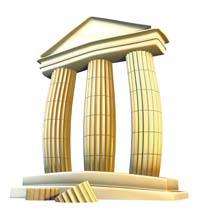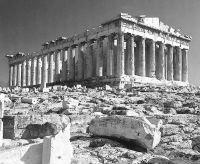Perspective, enemy of perfection
2011/04/01 Roa Zubia, Guillermo - Elhuyar Zientzia Iturria: Elhuyar aldizkaria

The Parthenon was built with carved marble pieces and placed one by one. There were about 13,400 blocks. According to experts, they had to make some models and many long and precise mathematical calculations to give the proper shape to each piece. The truth is that it must be done in all important constructions, but in the Parthenon it was a particularly difficult work, because it is a great trompe l'oeil, an optical effect that gave it the perfect appearance, according to the aesthetics that the Greeks of the time considered perfect.
The parthenon resembles a simple design, which seems supported at right angles. Its base is rectangular and at first glance seems to be constructed with straight lines on this base. It seems that blocks can change places: it seems that all columns are equal and a block of a column can be part of the contiguous column. But if we measure it with great precision, it is clear that this is not true.
The supposed horizontal straight lines are convex curves and the supposed vertical straight lines are bent inwards. In both cases they have a very small curvature, for example, the curvature of the front columns corresponds to a radius circumference of about 1.5 kilometers. It should also be noted that this curvature was applied to columns of 10.4 meters.
This proportion is undetectable at first sight and the Greeks could not draw the same circumference. However, they used mathematical tricks to calculate the shape of each block in the column. There were no big differences between the block and the block, but all the blocks are different and the architects got the precision of the size of a hair when assembling a block with the contiguous.
Restorers say that all blocks are different from each other, each can have a single position. XX. The restoration works carried out in the early twentieth century changed the blocks, seriously affecting the structure. Therefore, for today's restorers, the Parthenon is a great puzzle of thousands of pieces, without instructions, with many pieces and messy. And the pieces are very heavy blocks of marble.
The prosperity of Pericles
It was also a puzzle for those who built it, but with blocks from the beginning. We do not know how they did, but we do know that the team of architects Kalikrates e Ictinos built it in less than nine years, in the 5th century BC.
It is a great work of the mandate of Pericles: Pericles ruled Athens after winning a war against the Persians. Despite the war, the city was destroyed, but it had a great source of income; after the war more than 200 urban states met in the Delos Confederation to protect themselves. Athens had a lot of money -- and men and boats -- for being the head of the confederation's military support. It was the most fruitful time of ancient Greece; Athens was rebuilt by Pericles and promoted science and art. And after the repair works of the city, it was the turn of the Acropolis, a sacred hill full of temples. There they built the Parthenon.
Democracy had just been born and they decided to vote if the Acropolis had to be rebuilt. And in the Parthenon the cost of the building was carved in stone in the Acropolis for the people to see it. They spent 469 talents on silver, an amount that according to some experts can be compared to the current $100 million.
The cost of the parthenon has come written, but there are no traces of the plans of the building. Although the experts are direct, that is, they used mathematical calculations and models, they do not have the XXI. Last until the 20th century. And the victims of this lack of data are now restorative. The recovery of the part of the Parthenon that remains without falling has exceeded 30 years, and the work will continue.
There may be no possibility of lengthening much, as the remaining part is in grave danger of falling. Fortunately, the aesthetic criteria with which the Parthenon was built extend also in other buildings of the time, which has facilitated the work. Analyzing the Demeter temple of the island of Naxos, for example, experts understood some of the constructive methods of the Parthenon.
These constructive methods were governed by the aesthetics of the time. Straight lines, by the effect of perspective, take the form of inclined lines. It is an effect that opposes the classic criterion of beauty. The ancient Greeks wanted to see straight lines in these temples, for which they had to build all the curved lines. It is a great paradox, but the architects Kalikrates and Ictinos had advanced mathematics and engineering to deal with it.

Gai honi buruzko eduki gehiago
Elhuyarrek garatutako teknologia





